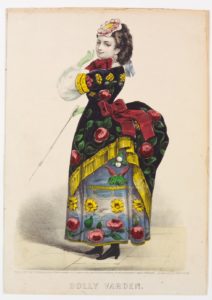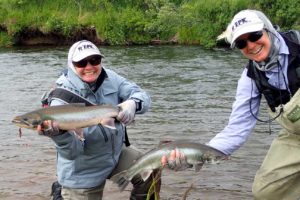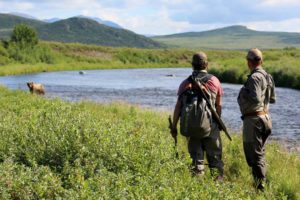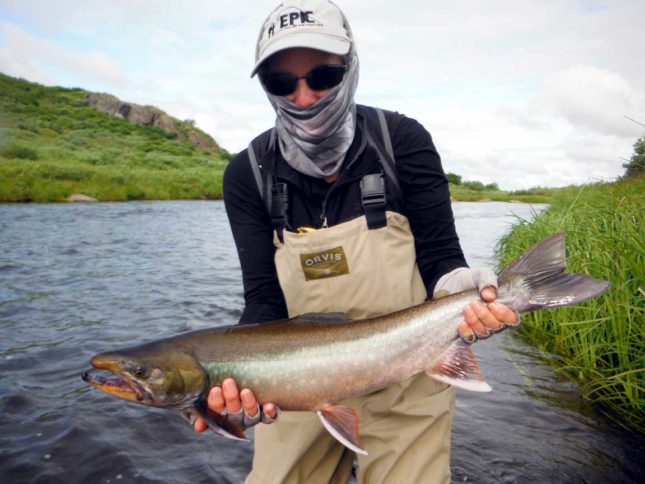Epic Blog
Seven Species Series: Dolly Varden
08.03.20
Part Four: Dolly Varden
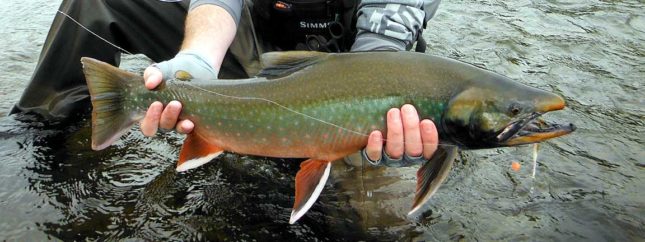
Dolly Varden are numerous, voracious, hard fighting, and love egg patterns. This one is starting to show their famous spawning colors.
A quick rewind
Northern California, 1872. A group of well dressed men stand huddled together on the grounds of a rustic fishing resort nestled on the banks of the Sacramento River. They have returned triumphant from another successful outing to the McCloud, a pristine high mountain tributary to the Sacramento River, and have brought back with them their days catch. They carefully remove the fish from their wicker creels, laying them out neatly under the manzanita and pine.
As they puff cigars and converse amongst themselves, a young girl approaches from the main house. She wears a magnificent dress, finely crafted and richly ornamented in a dazzling display of vibrant colors. She is the niece of the Inn keeper, and has seen many times before the array of fish that now lay at her feet. Some of them are the renowned rainbow trout. These ones are redbands, who will one day become the standard-bearer for their kind. The others, with their dark bodies and light spotting are simply referred to as Calicos. Finally, one of the gentlemen cajolingly asks the young girl a question regarding the spotted fish,
“What do you say, what shall we call these fine trout?”
Her reply is simple, “Dolly Varden.”
A tale of too many names
This is the origin story of how Dolly Varden acquired their name. It’s a literary reference to the Charles Dickens novel ‘Barnaby Rudge‘ in which there is a character named Dolly Varden. This name would become synonymous with a contemporary style of women’s dress made popular by the novel and its description of the aforementioned characters showy attire. By the 1870’s, a Dolly Varden style dress was all the rage, and the adolescent niece of the Inn keeper, who was not only reading the Dickens novel at the time, but who had also finally acquired her own dress of this style, was alluding to these two things when she was asked the fateful question of what to call this mysterious fish.
The name stuck. Being propagated by a handful of the individuals who stood on the lawn with their catch that day as they returned to San Francisco and submitted the name of this newly anointed fish to the annals of public record. But there were a few problems to sort out. First off, the newly named fish were not actually Dollies at all. They were bull trout, a cousin to the Dolly Varden.
Into the weeds
Dolly Varden are a type of char. This group of Salmonids is characterized by having a dark body with light spots. Consider that trout are the opposite, having a light body with dark spots. All char belong to the same genus, Salvelinus. This includes brook trout, lake trout, bull trout and Arctic Char. Seems simple enough right? Now consider that the name Dolly Varden is still commonly used as a bi-word for Arctic Char. We hear it all the time at our two remote fly fishing camps, one name being swapped out for the other.
It should be noted that it wasn’t until 1980 that scientists officially separated Bull Trout from Dolly Varden. The former would become S. Confluentus, the latter would remain S. Malma. So we can now say with some clarity that while these two fish greatly resemble one another, they are not the same thing. But what about Arctic Char and Dolly Varden?
Stay tuned for the next installment for that answer. Until then, we turn to my Alaska.
The Elbow
Mid July, 2018. Today we make the trek from our drop point on the banks of the large glacially stained river to the Elbow. You could cut a straight line to our target from where we emerge from the steep bank onto the open tundra, but to do so would be to invite misery into the beginning of our day. It’s too early in the morning for that, so we take the longer route over better ground. With me are Hollis and KC, an aunt and nephew from Texas. They have each fished both camps before, their last trip to OUTPOST only two years prior.
After a half hour walk we approach the creek where it breaks against a series of piano sized boulders and makes a hard bend to the right. The water is swift at the head of the run as it cascades into the turn, frothing over a lone boulder that sits resolutely in the middle of the creek. As it rounds the corner it carves a deep trench, strewn with large submerged shelves of rock, and then fans out, gradually losing depth towards the tail of the run. It’s a prominent fishing hole and one that seldom disappoints.
That’s some fish
When I recall that morning it seems like it did not take long before we were into our first fish. Both aunt and nephew are well accomplished anglers, and I served mostly as a watchdog, keeping an eye out for any uninvited four-legged guests. KC was fishing a mouse pattern, and whether he started at the head of the riffle before Hollis I don’t remember, but he was definitely below us as Hollis began to work her way through the meatiest part of the run.
She had on a pink and tan Dali Llama, the ultimate flesh fly. It’s a difficult pattern to cast, especially here, where a grove of alders hugs close to the steep bank and creates a considerable obstacle of overhanging branches. She managed it gracefully, and sent a long arcing cast across the width of the creek, her fly landing with a smack amidst the rock garden on the far side. Normally, it’s preferable to strip a streamer pattern, but here, with the heavy current coursing through the ditch all that is necessary is a series of big upstream mends to let the fly sink. The current will do the rest.
Mid stream there are a series of submerged rocks. Once her fly moved just beyond them the line jarred tight, and I saw immediately from the severe bend in her rod that she was on a good fish. It didn’t jump after being hooked; not a trout, maybe a salmon. But then it shook violently, boiling just below the water’s surface. Suddenly it burst into a fit of short erratic runs before abruptly stopping again to resume its arrhythmic convulsions. Finally I saw it writhing below us, a brilliant streak of silver flashing in the black tea stained water. It was a dolly! And it was big.
Can we get a picture?
I had finally managed to get the leader in my hand as the silver fish thrashed at my knees in a series of spasmodic crocodile rolls. Dollies are, in my opinion, the most difficult fish to handle without the aid of a net. Their small scales give them an unusually slick surface. A characteristic they share with all of their char brethren. Perhaps this trait is ironically spelled out in their latin name, Salvelinus. Salve being another word for grease or ointment. At any rate, they’re a handful. They’re also masterful escape artists. They roll, twisting the line and sometimes wrap it around their bodies. You’ll get so distracted trying to untangle the mess that they often slip away before you can put a firm grip on them.
Today luck is on our side. This is a truly large fish with an ample wrist at the base of the tail and wide belly to hold onto. A male, with a well defined kype (hooked upper jaw) and muscular shoulders rising from behind its head. It’s still shimmering in its ocean armor. Its dark slate grey head and back are set in stark relief against the electric sea green metallic skin that extends below its lateral line. Its belly is still snow white, like a shark. If you look carefully you can make out the blushing pink dots that are visible along the flanks. Definitely picture worthy. Hollis and I dance around one another, balancing fly rod and camera all while trying to insure the fish stays in our hands. Finally we successfully make the transfer. Hollis proudly holds the fish up for the camera. In her hands is the biggest Dolly I have ever seen. Not quite 30 inches, but not far behind.
……to be continued here.
Find more Machete articles here.
Posted in All Posts, Fishing, OUTPOST

